Canadian
Gold Rushes
El
Dorado Fever
When the paddle wheeler
Commodore
arrived
at Fort Victoria from San Francisco on April 25, 1858, the 450 passengers
on board more than doubled the size of the town that had no hotels or other
public buildings to accommodate them. This did not really matter, however,
as those arriving were eager to seek their fortune up British Columbia’s
Fraser River in the biggest gold strike since the California Gold Rush
of 1849.
In the next three
months an estimated 27,000 gold seekers sailed from San Francisco to Victoria.
Another 8,000 travelled overland through the Oregon Territory to seek their
fortune. Their first main stop was at the confluence of the Thompson and
Fraser rivers. Then, in the 1860s, it was on to the Cariboo district until
the dramatic discovery of gold in the Klondike brought worldwide fame to
the Yukon in 1898....
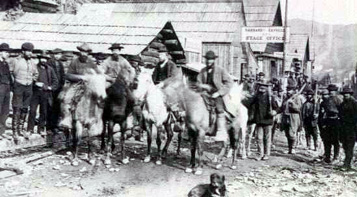 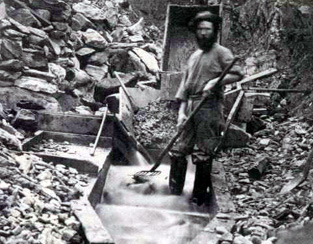 |
| 1. Barkerville
grew up around the 50-foot shaft sunk by William Barker whose gold discovery
along Williams Creek in 1862 yielded some $600,000 by 1866. The northern
terminus of the Cariboo Road, Barkerville was inhabited by 10,000 stampeders
by 1863. So much gold was being discovered in the region that some miners
hired agents with guns, as this 1865 Barkerville photo demonstrates, to
assure safe delivery of gold nuggets to Victoria. [Photo, courtesy National
Archives of Canada/C-088917] 2. Although British Columbia’s
Cariboo district was mined into the 20th century, the spectacular discoveries
were made in the early 1860s. Claims even then were feverishly reworked,
redug, and rediscovered. This Grouse Creek sluicer from near Barkerville
was still pocketing gold when Frank McLennan photographed him in 1867.
[Photo, courtesy National Archives of Canada/C-021575] |
Although reports
vary, consensus is that the Fraser discovery was actually made in 1856.
Donald McLean, the chief trader of the Hudson Bay Company in Kamloops,
reported to James Douglas, the chief factor and acting governor of Vancouver
Island, that Indians had brought him gold from the Fraser area. On receiving
the letter in February 1857, Douglas asked McLean to “collect a large party
of Indians,” and proceed to the gold district, and “make them search and
wash for the precious metal....”
Another letter from
Douglas that November suggested that McLean send the gold to Fort Langley,
near the mouth of the Fraser River, by February 1858, so that it could
be sent the next month to England. A California newspaper on April 11,
1858, confirmed this when it reported that “The Princess Royal,
a vessel belonging to the Hudson’s Bay Company, sailed on the 29th ult.
for England with 1,000 ounces of gold dust from the Thompson River Mines.”
Nine days after that
story appeared, the Commodore sailed from San Francisco for Victoria,
where the prospectors, on realizing they still needed to reach the mainland,
did not wait for steamers but built their own small boats, sailed across
the Strait of Georgia and up the Fraser River during the low water season
to Fort Yale. Even before reaching this isolated outpost, some began panning
up to five ounces of gold a day while others moved up river hoping to find
the mother lode.
Among the more experienced
miners was Peter Dunlevy of Pittsburg who, in May 1858, befriended Tomaah,
the son of an Indian chief. Tomaah told Dunlevy and his four companions
he could show them a river “where gold lay like beans in a pan.” By the
end of the month, these five were panning gold in Little Horsefly Creek,
just 12 hours before a second party arrived. The two groups joined forces
and started the Cariboo Gold Rush that drew thousands of prospectors over
the next decade to numerous creek beds containing gold.
Keithley Creek, discovered
in 1860 by veteran prospector Ben McDonald, was named for William Keithley,
one of the original party of four. Before the year was out they made a
second strike on Antler Creek. After staking their claims, William Keithley
and a partner returned to get supplies at a camp that had sprung up at
their initial strike. Their attempt to avoid alerting others came to nought
when they discovered, on leaving after dark, that “hordes of men were packed
and snow-shoed up, ready to follow the pair wherever they had come from.”
So wrote Donald Waite in The Cariboo Gold Rush Story (1988).
Other discoveries
in 1861 at Williams, Lightning, and Lowhee creeks (250 pounds of gold nuggets
were picked up in five weeks at the latter) prompted gold seekers, road
contractors, traders, pack train operators, con artists, card sharks and
prostitutes the world over, to leave their homes for British Columbia’s
interior. In 1862, Governor Douglas, who had earlier persuaded the miners
themselves to build a four-foot-wide mule trail to the Fraser strike, commissioned
an 18-foot-wide wagon road from Yale to the Cariboo, some 400 miles long.
By awarding contracts to a number of road builders that included The British
Army Royal Engineers, Douglas reinforced that the territory was British.
Not all, however,
reached the Cariboo that way. A party of roughly 200 left Toronto by train
in May 1862, bound for St. Paul, Minnesota, then by ox cart or ship to
Winnipeg, and by ox cart to the Rockies. Although a good trail to the gold
fields existed, there were no good trails from the foothills of the Rockies
and beyond. This caused incredible hardships and death before groups straggled
into Fort George and Fort Kamloops in mid-September. Another party of 26
from the coal mines of Wales who sailed around Cape Horn to sink shafts
at Lightning Creek in the summer of 1863 suffered from scurvy instead of
reaping gold.
An enterprising American
bought 23 camels from the U.S. Army (they could carry twice the load of
a mule) and shipped them to the Cariboo. Their soft hooves were not suitable
for sharp rocks, however, and many went lame. They were outfitted with
rawhide boots which worked, but the peculiar camel smell stampeded other
horse and mule trains. As a result of law suits, the camels were turned
loose, and so ended the “Dromedary Express.”
Even though many
of both groups squandered their fortunes one way or another, some who went
to the Cariboo made fortunes as gold strikers, or as traders. Isaiah Diller,
who struck gold on Williams Creek, vowed he would not leave until he had
mined his 240-pound weight. Stories claim he left with more than his weight,
returned to his mother’s New York farm the day it was being auctioned,
bought everything put up for sale, and returned it to his mother.
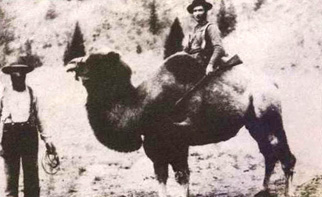 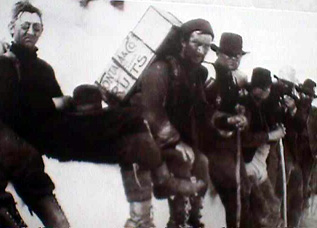 |
| 1. Getting
supplies to the Cariboo district was a problem. Oxen-drawn wagons and mules
were the main source of transportation. Of all the contrived methods for
transporting freight, the most bizarre was by camel. The odour, personality,
and soft hooves of the dromedaries proved, however, to be their shortcomings.
By 1864 the Dromedary Brigade of 23 was disbanded. [Photo, courtesy British
Columbia Archives and Record Services/A-347] 2. Men without
smiles stop for respite on their way through the Chilkoot Pass. Survival,
not gold, must have been foremost on their minds during the severe winter
of 1897-98. [Photo, courtesy National Archives of Canada/C-16460] |
Another successful
miner, German-born Edward Stout, was wounded by hostile Indians before
discovering Stout Gulch on Williams Creek. He married and settled in Washington
State where he died just shy of being 100 in 1924. Henry Beatty of Toronto
returned home and invested his find in a shipbuilding venture that made
him a millionaire. Bob Stevenson, who arrived with his father as a lad
from Glengarry County, Ontario, and who stayed after his dad went home,
became a shrewd trader and eventually a mine owner. One of the people he
helped was another Glengarry native, John A. Cameron, who made and lost
a fortune but is chiefly remembered as the man whose wife died and who,
to keep a promise, had her body dug up twice before reinterment in Glengarry.
Her remains were dug up a third time when a U.S. newspaper raised the suspicion
that Cameron had hidden gold in her coffin. The newspaper was wrong.
Billy Barker, who
left England and wife and daughter for the California Gold Rush, struck
it rich in the Cariboo and married another English girl at Victoria in
1863. They returned to Barkerville, the town named after him, which became
the largest community west of Winnipeg – a title that would be relinquished
to Dawson City during the Klondike strike some 35 years later. As in Dawson,
hurdy-gurdy girls were transported from California to dance with the miners
at one dollar a fling.
An Anglican minister
in Lillooet arranged to have English girls brought out to marry the miners,
but some wed in Victoria and some who reached the Cariboo turned to prostitution.
They were a tough lot according to the Victoria Colonist. “They
dress in male attire and swagger through the saloons and mining camps with
cigars and huge quids of tobacco in their mouths, cursing and swearing,
and looking anything but the angels in petticoats heaven intended they
should be.”
The Cariboo was mined
well into the twentieth century, long after the last and greatest gold
rush of the period – the Klondike – was but a memory. As early as 1873
some prospectors were searching for gold in the Yukon. It took another
23 years, however, before there was a bonanza discovery. Two men are given
credit for the strike: Robert Henderson, a native of Lunenburg, Nova Scotia,
and George Carmack, the son of a Fortyniner.
Carmack, in the Yukon
more as a trader than prospector, was married to an Indian and had two
close friends, both native: “Skookum” Jim and “Tagish” Charlie. Henderson
met and urged Carmack in 1896 to test the Rabbit Creek gravel bed near
present-day Dawson City, cautioning the California-born Carmack never to
disclose his findings to anyone, especially his Indian friends. He didn’t
want Indians registering any gold claims! On August 16, 1896, Carmack discovered
one of the world’s richest gold beds at what later would be called Bonanza
Creek. He not only disregarded Henderson’s caution but happily shared his
findings with anyone he met on his way to register his claims.
Within weeks prospectors
from all over the territory converged near present-day Dawson City. News
of the strike did not reach the outside world until 11 months later when
two steamers arrived at Seattle and San Francisco in mid-July 1897 with
tons of gold and a number of celebrating prospectors. This signalled a
stampede “heard round the world.”
Lured by both the
thought of becoming rich and the adventure of finding gold in the depressed
economy of the period, thousands from around the world stormed north to
the Klondike. Some became rich, but thousands suffered incredible hardship
and death in their quest for the elusive mineral that could be found in
abundance in one spot and nowhere in the muck of shafts dug only a few
feet away.
A dozen routes to
the discovery were possible. The easiest but costliest was by sea from
San Francisco, Seattle, or Victoria to St. Michael, Alaska, on the Bering
Sea, where steamboats could travel 1,700 miles up the Yukon River to Dawson
City. The winter freeze-up, however, stranded all but 43 of the 1,800 people
who travelled that route in the summer of 1897, and it was July 1898 before
those who persevered reached Dawson.
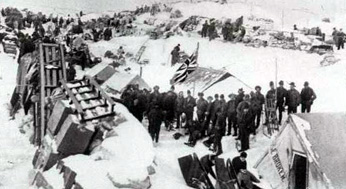  |
| 1. At
the top of the Chilkoot, the Canadian Customhouse and the North West Mounted
Police rigidly controlled border crossings and kept law and order. [Photo,
courtesy National Archives of Canada/C-1277] 2. In the land
of the midnight sun, one could “rock for gold” all day long and easily
lose track of time. There was so much gold at Bonanza Creek, a tributary
of the Klondike River, that it was difficult for a “rocker” to stop looking
for gold for fear someone else might discover what he neglected to find.
[Photo, courtesy National Archives of Canada/PA-16223] |
Another 3,500 took
the all-American route from Valdez, Alaska, to avoid Canadian customs,
but many could not cross the 20-mile-wide glacier they encountered beyond
that port city. Only a few reached the Klondike taking this route. Two
other all-American routes proved equal failures. Two Canadian routes, one
through British Columbia and another from Edmonton, were equally devastating.
Frostbite that caused gangrene, snowblindness, scurvy, starvation, even
suicide were the result. There was no easy access to the gold fields!
Most of those who
eventually made it did so through two passes, the White and Chilkoot. The
White, a 45-mile narrow, winding route of gumbo, boulders, crevices, rivers,
and hills, became the burial ground for more than 3,000 overworked, ill-treated,
and ill-fed pack horses driven by some 5,000 people attempting the route.
“The horses died like mosquitoes in the first frost and from Skagway to
Bennett, they rotted in heaps,” wrote novelist Jack London.
Many who reached
Skagway, at the head of Alaska’s Lynn Canal, became victims of another
kind – victims of the Soapy Smith gang that cheated, robbed, and even murdered
at will, since Smith controlled the town, which NWMP Superintendent Samuel
B. Steele described in his memoirs as “little better than a hell on earth.”
On the Chilkoot Pass,
people themselves became the beasts of burden as animals couldn’t make
the final four-mile climb from Sheep Camp to the summit. Everything had
to be carried, and everything meant at least a year’s supply of goods,
a rule rigidly enforced by Steele and his North West Mounted Police stationed
at the summits of both the White and Chilkoot passes. For those who couldn’t
afford to pay Indian packers to carry their supplies, it meant making 30
to 40 trips to the summit and beyond to Lake Bennett. Those who made it
then worked feverishly building boats of every description to take them
the remaining 500 miles to the gold fields.
Spring breakup occurred
in late May and “the whole freakish flotilla of 7,124 boats loaded with
thirty million pounds of solid food was in motion,” wrote Berton in his
1957 bestseller, Klondike. On reaching Miles Canyon, however, 150
boats were destroyed and five people drowned in the first few days when
they attempted the five-mile run of the Squaw and White Horse Rapids.
A handful of Mounties
with Steele in command arrived. As he did in connection with the supplies
required, Steele dictated rules. A corporal with riverboat experience was
put in command to assess the suitability of each boat, provide experienced
men to sail them when necessary, and ordered women and children to walk
beyond the rapids five miles distant. A penalty of $100 was also imposed
for anyone breaking these orders, and while some resented his dictum, few
boats or lives were lost among the estimated 30,000 people who traversed
the route that same summer.
As a result of this
influx, Dawson became a city overnight. Unlike Skagway, there was little
crime, even though the city was wide open six days a week, 24 hours a day.
Only at Saturday midnight did the saloons and dance halls close until 2
a.m. Monday, another regulation imposed by Steele who turned a blind eye
to prostitution and drinking but banned guns and imposed stiff penalties
on card sharks and con men of any kind. Sentences for breaking the rules
imposed by the NWMP were steep, the most severe being a sentence to the
woodpile – which could mean months of hard labour sawing wood to heat the
government buildings in Dawson.
Dawson remained the
biggest city west of Winnipeg until the discovery of gold in Nome, Alaska,
in mid-summer 1899. Within a week, 8,000 miners left and the Klondike rush
was over. Gold continued to be mined by a few major companies with sophisticated
equipment for another half century but Dawson’s main interest and industry
became tourism when Parks Canada rebuilt a number of the old buildings.
To this day thousands visit the historic site each summer. Of course, in
1998 Dawson will experience still another stampede – people wanting to
celebrate the 100th anniversary of the most famous gold discovery of all
time....
The Cariboo and Klondike
gold stampedes of the nineteenth century gave impetus to vast and rich
mineral discoveries in Canada throughout the twentieth century. Such eurekas
have continued to make Canada the centre for global mineral exploration
and have ensured Canada’s position as the mining capital of the world.
Mel James





